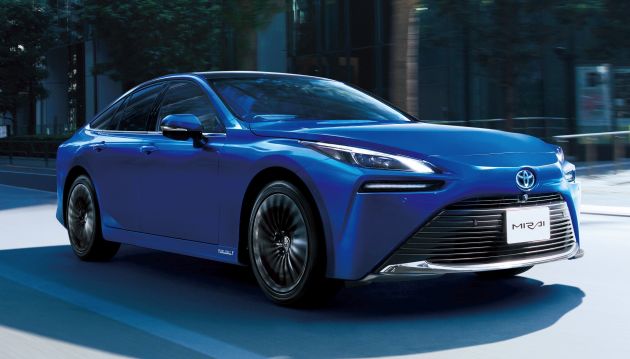2021 Toyota Mirai launched in Japan, priced fr. RM277k
Toyota has officially launched the second-generation Mirai in Japan. The hydrogen fuel cell electric vehicle (FCEV) goes on sale in its domestic market from today, available in two variant grades, a standard G and a high-end Z.
Retail prices start from 7.1 million yen (RM277,150) for the G grade, with a couple of equipment packages available for it. An “A Package,” which includes Toyota Teammate Advanced Park functionality and other features, brings the price to 7.35 million yen (RM287,000), while an “Executive Package” with enhanced comfort increased the price to 7.55 million yen (RM295,000).
Meanwhile, the Z is priced at 7.9 million yen (RM308,380), and adding the optional “Executive Package” for the variant takes it to 8.05 million yen (RM314,200), but according to a Kyodo News report, the automaker will be providing some 1.4 million yen (RM54,650) in subsidies and tax breaks to Mirai customers in a bid to push hydrogen along.
Not much surprise in terms of details – following the announcement of its impending arrival in October, the JPD20 was detailed last month, first through an early access viewing provided to selected Japanese journalists, and then from a specification breakdown of the US-market version.
The new Mirai is underpinned by a Toyota New Global Architecture (TNGA) platform, in this case the GA-L full-size chassis, which brings with it a switch to rear-wheel drive. The new car is more sizeable than its predecessor, measuring in at 4,975 mm long (+85 mm), 1,885 mm wide (+70 mm) and 1,470 mm tall (-65 mm). At 2,920 mm, the wheelbase length is also up from the old car by 140 mm.
The new Mirai utilises three tanks to store the hydrogen fuel used to power its electric motor, and this has resulted in its operating range being increased to 850 km, or 30% more than the 650 km that the first-generation Mirai (which had two tanks) was capable of. Despite the additional tank, the repackaging of the fuel cell layout has allowed for additional seating in the second row, making the new car a five-seater.
No shortage of safety and driver-assistance systems. The Mirai comes equipped with the latest Toyota Safety Sense tech suite, which now includes a smarter Pre-Collision System with Pedestrian Detection that can see cyclists, pedestrians, and even an oncoming vehicle or pedestrian at an intersection when performing a left-hand turn.
This system also comes with an emergency steering assist function, designed to stabilise the driver’s emergency steering manoeuvres within their lane while avoiding a preceding pedestrian, bicyclist or vehicle.
Also new is full-speed Dynamic Radar Cruise Control (DRCC), which can be activated above 48 km/h and will bring the car to a complete stop if necessary, while also being able to resume moving afterwards. The DRCC system also allows for smoother overtaking of slower vehicles, providing an initial increase in acceleration in preparation for changing lanes once the driver engages the turn signal.
Additionally, as a part of the support to prevent accidents caused by pedal misapplication, the Mirai comes standard with “Plus Support,” which suppresses acceleration if pedal misapplication is detected, even when there are no obstacles in the vicinity.
By next year, the Mirai will also be equipped with new advanced driving assist functions that have been developed based on the automaker’s Mobility Teammate Concept tech. The premise is a level of autonomous driving (or system-conducted driving, as the company puts it) accomplished with the aid of Toyota Teammate Advanced Drive.
When driving on an expressway, the onboard system appropriately detects actual driving conditions and makes determinations to provide operational support – under the driver’s supervision – to keep the vehicle in its lane, maintain distance from other vehicles, navigate a lane split, change lanes and overtake other vehicles, freeing the driver from operation of the accelerator, brakes, and steering.


Other driver assistance kit include the previously mentioned Toyota Teammate Advanced Park assist, which handles all operations (steering, acceleration, braking and gear changes) for a parking procedure.
Away from the driving aspect, the Mirai can be utilised as an emergency power source during power outages caused by disasters and for other emergency situations, offering electricity through two different power supply routes. The first is through connecting the car’s external power supply outlet to a dedicated external DC electric power supply system. Operating under this guise, it can supply a maximum of 9 kW DC.
The other takes a more direct AC path, feeding electricity (100 volts, 1,500 watts) through two accessory outlets to power electric devices. This emergency electricity supply system is capable of providing electricity to an ordinary household (in Japan) for about four days at an average consumption rate of 400 Wh.


Another novelty is the premise of “minus emissions,” in which an air purifier system takes in air and cleans it (down to PM2.5 particulate level) for use in the fuel cell stack before releasing the purified air back into the atmosphere.
Interior kit for the Mirai includes an eight-inch TFT LCD digital instrument cluster and a 12.3-inch touchscreen infotainment system with Android Auto and Apple CarPlay support, as well as a 14-speaker JBL audio system and Qi wireless mobile charging.
Eight exterior colours are available for the Mirai in its domestic market, including Force Blue Multiple Layers, a newly-developed colour the automaker says provides shading and vividness to accentuate the car’s styling. Toyota says it is boosting production capacity to 30,000 units a year for the Mirai, which will be assembled at its Motomachi plant in Aichi Prefecture.






























The post 2021 Toyota Mirai launched in Japan, priced fr. RM277k appeared first on Paul Tan's Automotive News.
from Paul Tan's Automotive News
Read The Rest:paultan...





.jpg)
Post a Comment